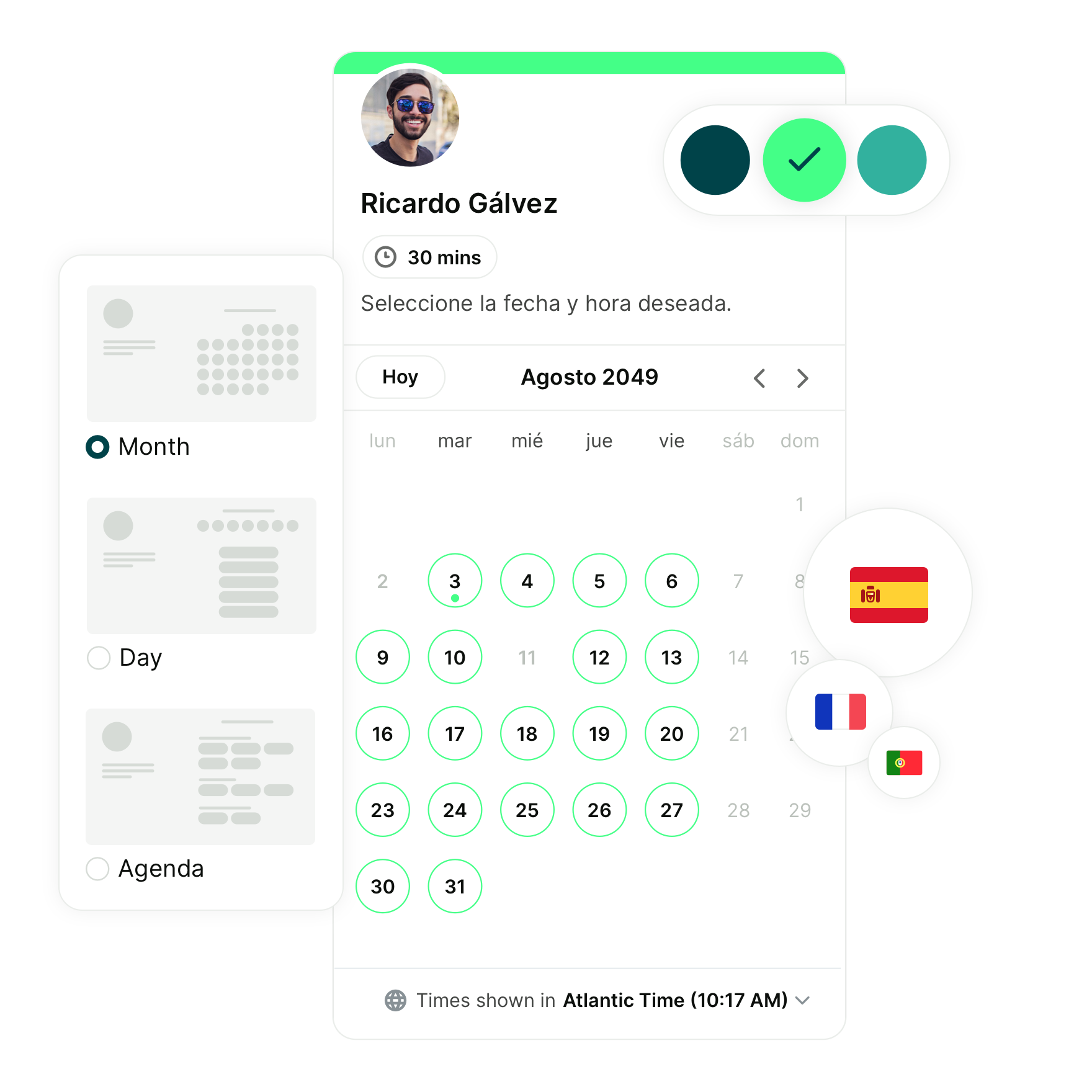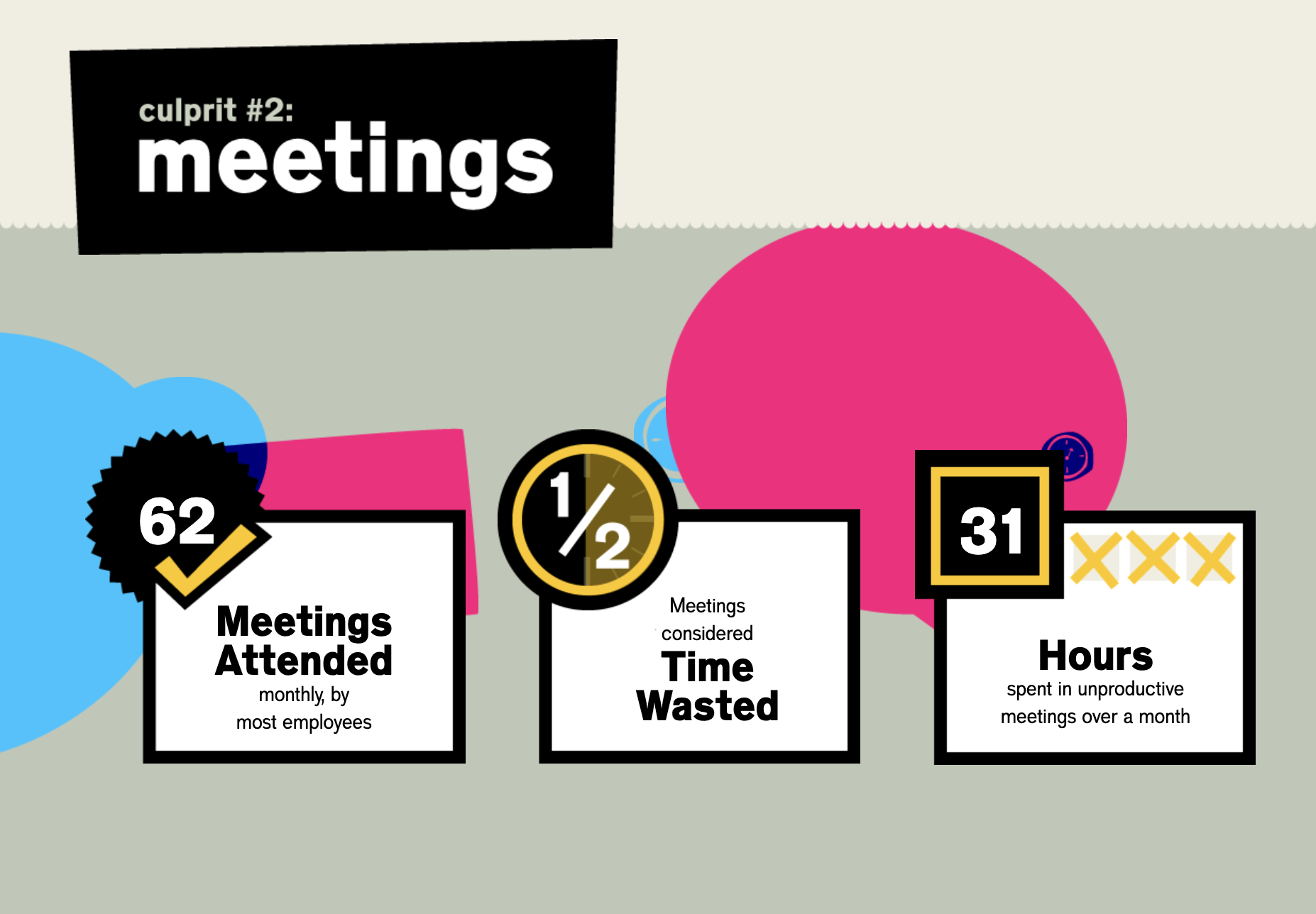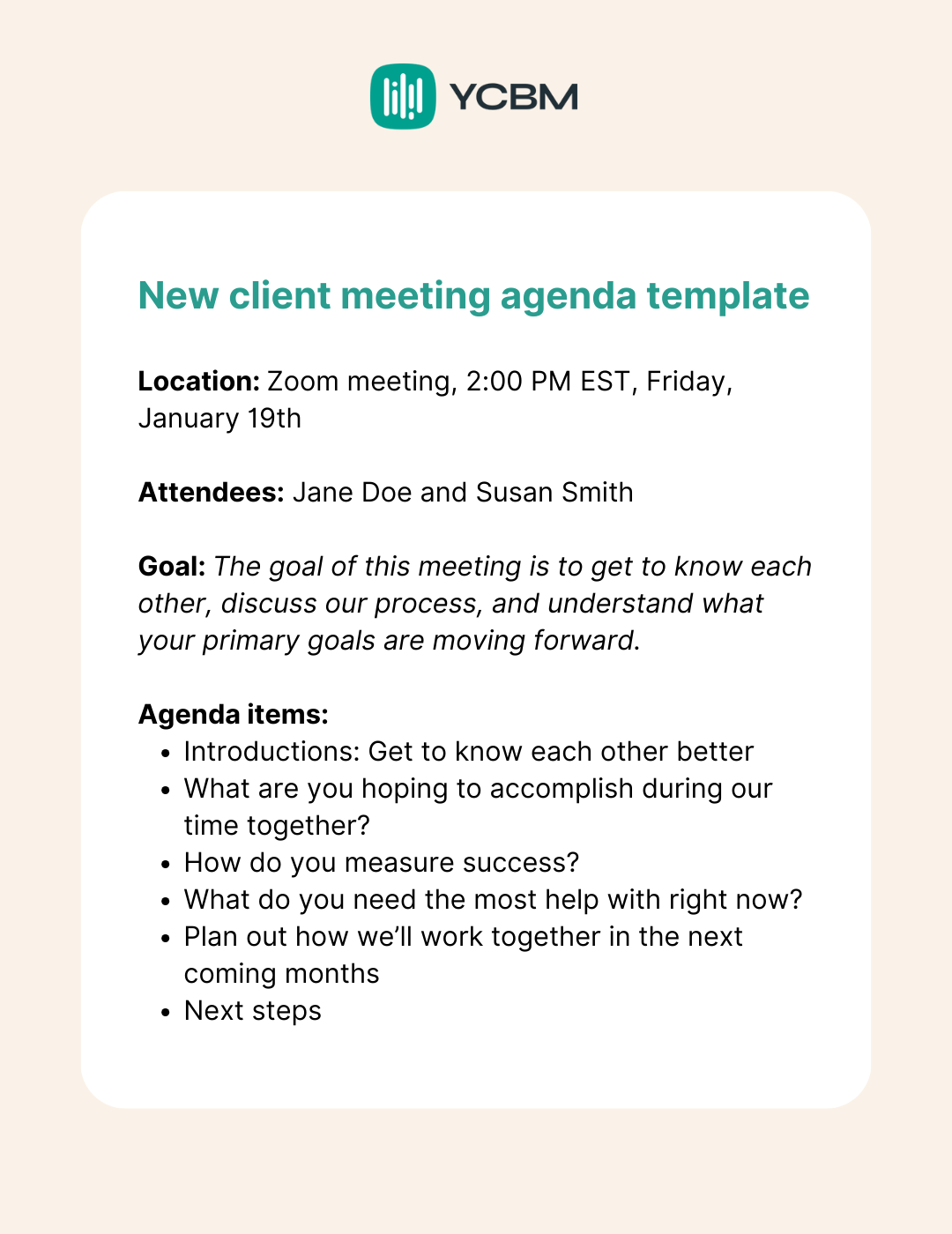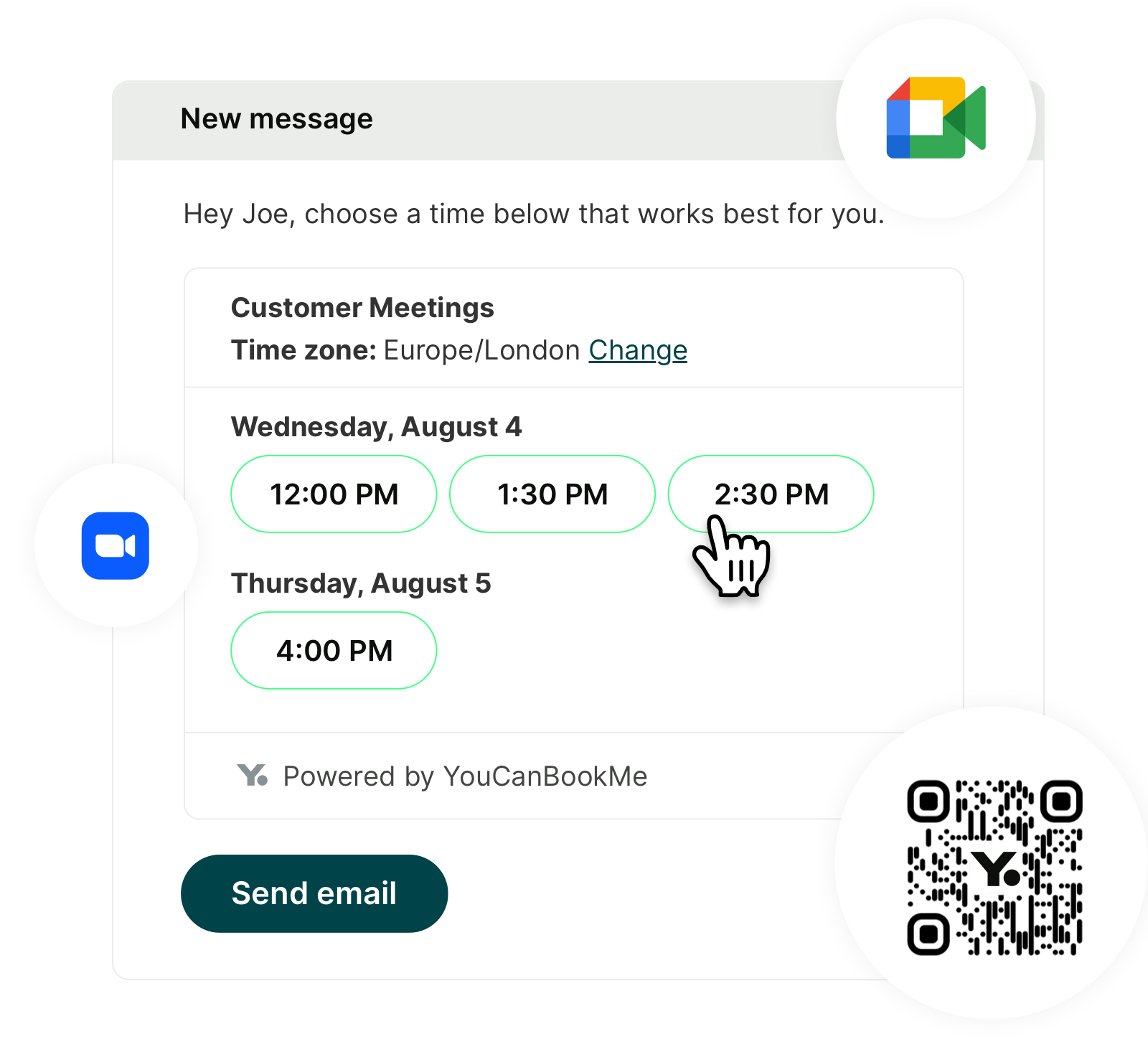10 Hacks to Improve Meeting Productivity in 2026
Your team deserves efficient, focused gatherings. Get ready to say goodbye to wasted minutes and hello to meetings that leave you energized and brimming with accomplishment.

Beatrice Visser

Ready to book more meetings?

Contents
Have you ever found yourself stuck in endless meetings that seem to drag on without purpose?
Not only is it a waste of everyone's time... but it's DRAINING too!
Well, fret no more because we're diving into the ultimate guide on how to improve meeting productivity before, during, and after every call.
In this read, we'll unpack insightful strategies and practical solutions to help you run your meetings, better!
Let’s dive in!
The cost of unproductive meetings
Did you know that having fewer meetings is one of 5 proven ways to increase employee working efficiency? In fact, people waste a lot of time in meetings.
A report by Atlassian found that one of the main culprits of wasted time at work is meetings.

According to Verizon Conferencing (2020):
- Busy professionals attend 60+ meetings monthly
- In-person meetings with travel are over 7 times costlier than audio conferences and nearly 3 times pricier than video conferences
- In-person meetings cost $5,197.50 on average, while audio conferences cost $689.24 and video conferences cost $1,700.69
- In-person meetings require over 53 hours of preparation, travel, and attendance, compared to less time for virtual meetings
- Business travel adds stress due to concerns about family time and work responsibilities
- 92% of meeting attendees value contributing, despite distractions
- 89% believe technology will make meetings easier in the future
These statistics paint a clear picture: there's a critical need to improve meeting productivity. But where do we begin?
Let's explore some actionable tips!
10 Hacks to improve meeting productivity
We have some amazing hacks for before, during, and after your meeting to ensure you have a productive meeting every single time.
Before the meeting:
1. Make scheduling easier
It can be really frustrating and time consuming to send back and forth emails to find the right time. Especially when there are several scheduling tools on the market, like YouCanBookMe, to make the booking experience frictionless. When you make it easier to book time on a calendar, the likelihood of actually booking time increases.
If meeting bookings are a core part of your business, it’s important to keep the most popular booking times open and available for existing and potential clients to pick from. A recent report by YouCanBookMe found that the most common booking time is 10 am.
While some people are morning people and others are not, finding the sweet spot might be a game changer when it comes to maintaining focus during a meeting.
Example: Imagine trying to schedule a coaching session with a client. Instead of exchanging numerous emails with various availability windows, and delays in time waiting for the other to reply, you could send your client a booking link and they’ll immediately be able to see and pick what time slot works best for them. How great is that?
2. Set meeting objectives
Send out a clear, effective meeting agenda in advance, outlining the purpose of the meeting, desired outcomes, and any pre-reading or preparation needed by attendees. This not only ensures everyone comes prepared to discuss, but also offers participants the opportunity to add any pressing matters to the meeting agenda beforehand. This fosters more productive meetings in the long run.
Example #1: Meeting a new client for the first time is your chance to make a lasting impression. By sending a meeting agenda ahead of time, you ensure a productive meeting by letting your client know what to expect and what information to have ready. This small step shows you're organized, prepared, and committed to their needs, instantly building trust and setting a professional tone.

Example #2: A financial coach prepares for a client struggling with budgeting. The coach sends a client meeting agenda to help set the stage for their upcoming coaching session. By sending the agenda and objectives of the meeting in advance, the client has ample time to think through the questions and topics they’ll cover, as well as have an opportunity to add in items they’d like to tackle so that the coach can prepare too.
Regardless of the topic or purpose, a clear meeting agenda is essential for leading an effective meeting. It keeps discussions focused, organized, and productive. If you're unsure where to begin, explore meeting agenda templates tailored to your business needs, helping you ensure every meeting runs smoothly and achieves its goals.
3. Pre-meeting preparation
Be selective with your invites. Only invite individuals who directly contribute to the discussion or decision-making process. Share relevant information (reports, documents) and meeting agenda beforehand with others who need to be informed, freeing up meeting time for focused discussions.
If any documents are in PDF format and require editing or customization before sharing, use a PDF to Word converter to simplify the process and ensure the materials are tailored to the meeting's needs.
Consider maximizing AI tools to efficiently disseminate pre-meeting materials. For example, an AI avatar can deliver key information in an engaging video format, keeping everyone informed and updated before the meeting starts.
Leveraging the RACI model can help you determine who to invite. Here's how:
- Responsible (R): These individuals are directly responsible for completing tasks related to the discussion or decision. They must attend the meeting to actively contribute.
- Accountable (A): This person holds ultimate responsibility for the success of the project or task being discussed. While they may not need to attend every meeting, ensure they are aware of key discussions and have a designated representative if needed.
- Consulted (C): These individuals have valuable insights or expertise relevant to the topic. Depending on the meeting's focus, they may be invited to contribute their perspective or answer specific questions.
- Informed (I): Stakeholders who fall under "Informed" typically don't require meeting participation. Sharing the meeting agenda, meeting minutes, and any relevant documents afterwards keeps them updated without taking away from focused discussions.
(Source)
Encourage participants to review the agenda and any pre-meeting materials to ensure a productive discussion. Moreover, providing clear objectives and expectations for the meeting can help set the stage for focused and constructive dialogue. If you're presenting a deck during the meeting, depending on your tech stack, you can also consider using an AI PowerPoint generator to create beautiful, on-brand, and engaging decks.
Example: In a marketing team meeting focused on a new ad campaign, only team members directly engaged in the creative process and budget allocation are sent meeting invitations. The marketing manager ensures that target audience demographics and brand guidelines are shared in advance, allowing attendees to arrive prepared with ideas.
The VP of Marketing receives updates on the meeting afterward. While their direct involvement wasn't needed for the detailed discussions, their awareness of the decisions made is crucial.
4. Prioritize essential meetings (and async the rest)
Before scheduling a meeting, consider alternative methods of communication like email or different communication tools.
Let's also consider the benefits of asynchronous tools such as Bluedot’s AI note taker. Instead of scheduling real-time meetings that can interrupt focus time, why not try recording short videos to convey updates or ideas? This way, team members can watch and respond on their own time.
Example: A design team needs to finalize the layout for a new website. Instead of scheduling a meeting, they could use a collaborative design platform, like Figma, where team members can leave feedback and suggestions on the design mockups async, eliminating the need for a dedicated meeting.
During the meeting:
5. Screen sharing
If your meeting involves remote participants, utilize collaborative tools like screen sharing, whiteboards, or document editing platforms. These tools can boost meeting productivity by:
- Visually guiding discussions and presentations
- Facilitating brainstorming sessions in real-time
- Allowing everyone to participate and contribute, regardless of location
Example: Imagine a marketing team scattered across different time zones, tasked with brainstorming ideas for a new product launch. Virtual whiteboards like Miro come to the rescue, facilitating a collaborative and engaging brainstorming session despite the physical distance.
6. Take notes
Taking thorough notes during meetings isn't just about documentation—it's a powerful strategy for increasing productivity. By actively engaging with the discussion and capturing key decisions, next steps, and action items, note-takers ensure that everyone remains focused and accountable. This also makes your life easier when it comes to writing your follow-up email.
To streamline this essential process and maximize productivity, consider leveraging a transcription tool like Bluedot's AI note taker for Google Meet.
Example: After the design team meeting, a designated team member uses this collaborative note-taking tool to capture feedback on the mockups and assigns clear next steps for revisions to specific team members with deadlines. The team member also did research on call recording laws before implementing this hack.
7. Encourage participation
Kick off meetings with icebreakers to ease participants into the conversation, creating a comfortable atmosphere for collaboration. Share the meeting agenda in advance to give individuals who prefer more time to prepare the opportunity to contribute confidently.
Utilize techniques like breakout sessions, polls, and open-ended questions to encourage active participation from all team members. This approach ensures that every voice is valued, leading to a more diverse range of perspectives and innovative solutions.
Example: During a marketing meeting to brainstorm new campaign ideas, the team leader uses an online polling tool to gather audience preferences for different marketing channels. This allows everyone to participate and contribute, regardless of their comfort level speaking up in a larger group and increase meeting productivity.
After the meeting:
8. Share information with all stakeholders:
Ensure everyone stays informed and aligned by promptly distributing meeting notes to all attendees and all relevant documents to stakeholders.
This is where the RACI model comes into play again, ensuring that only those who need to be in the meeting are invited, and the rest get updates on the focal points of the meeting afterwards. This transparency fosters collaboration and keeps everyone on track and informed.
Example: A meeting note taker tool can automatically generate and share a summary of the meeting with all stakeholders, ensuring alignment without the need for manual note-taking.
9. Clarify next steps and accountabilities:
When the meeting draws to a close, revisit the documented next steps and ensure everyone understands their assigned tasks and ownership. Briefly discuss any potential roadblocks and identify solutions to prevent delays.
Example: After the marketing team meeting, the team leader reviews the meeting minutes and documents the next steps for the new campaign launch. They ensure everyone understands their responsibilities, address any concerns about specific tasks, and brainstorm solutions for potential challenges that might arise. This final clarification solidifies accountability and prevents confusion or delays in execution.
10. Schedule the next meeting:
If a follow-up session is needed to keep the project moving forward, schedule the next meeting directly during the current one. This ensures everyone is aware of their upcoming commitments and avoids the need for additional scheduling emails. Remember, only schedule follow-ups if truly necessary to avoid unnecessary recurring meetings that hinder productivity.
Example: After a successful brainstorming session for a marketing campaign, the team leader recognizes the need to discuss and finalize the campaign budget. To maintain momentum and avoid delays, they propose scheduling a brief follow-up meeting the following day solely focused on budget allocation.
Important tools for a productive meeting
For every productive meeting, the right set of tools can make all the difference in ensuring clear communication, smooth collaboration, and proper follow-up. From scheduling to task management, here’s a breakdown of essential tools to help you run your meetings efficiently.
Online scheduling tools: Tools like YouCanBookMe simplify the process of scheduling meetings by eliminating the need for back-and-forth emails. They sync with your calendar, allowing invitees to select available time slots that work for everyone. Automated meeting confirmations, reminders, and follow-ups ensure everyone is prepared and on time, streamlining the entire meeting process.

Online calendars: To stay organized and keep all your meetings on track, syncing your scheduling tool with an online calendar is essential. Platforms like Google Calendar and Outlook let you add invites, set reminders, and view all your meetings in one place, making it easier to avoid scheduling conflicts and manage your time efficiently.
Video conferencing tools: Beyond standard video conferencing platforms like Google Meet, consider enhancing your meetings with AI-powered tools like Bluedot, which can automatically record, transcribe, and summarize your meetings. These tools save you time on manual note-taking and help ensure nothing important is missed during your online discussions.
Meeting agenda tools: For a structured and productive meeting, tools like Fellow and Evernote allow teams to collaborate on meeting agendas, take notes, and track action items in real time. This ensures that everyone stays aligned on key discussion points and that follow-ups are clear and actionable.
Task and project management tools: Platforms like Trello and Asana are excellent for managing tasks that come out of your meetings. They help track follow-up actions, assign responsibilities, and keep everyone accountable, ensuring that projects stay on schedule and meeting outcomes lead to real progress.
Wrapping up
By implementing these 10 practical hacks, you can increase meeting productivity for more effective meetings. Remember, the cornerstone of successful meetings lies in efficient planning, clear communication, and active participation from all attendees.
Are you ready to supercharge your meeting efficiency and eliminate the scheduling headache once and for all? YouCanBookMe is the ultimate solution. This user-friendly scheduling tool empowers you to:
- Effortlessly find a time that works for everyone with its intuitive scheduling features, saving you and your team valuable time.
- Showcase your professionalism and brand with customizable booking pages that reflect your unique style.
- Reduce no-shows and wasted time with automated reminders and confirmations, ensuring everyone is on the same page.
- Integrate seamlessly with your existing calendar and communication tools for a streamlined workflow.
- Schedule follow-up meetings directly within your current session in just a few clicks, keeping the momentum going and avoiding unnecessary back-and-forth communication.
YouCanBookMe isn't just another scheduling tool, it's an investment in your team's productivity and well-being. Experience the difference for yourself and try it for free today!
Subscribe to our newsletter
Get productivity tips, news, articles and resources.
Written by
Beatrice Visser
Based in Cape Town, South Africa, the Beatrice holds a BA degree in English and political studies, blending their passion for language with a deep interest in global affairs. With a knack for simplifying complex concepts, they offer clear and insightful insights into the world of technology.


